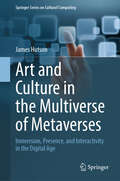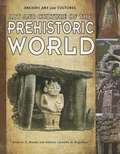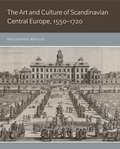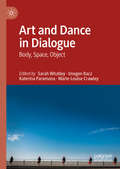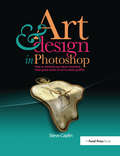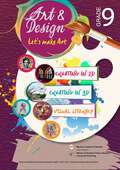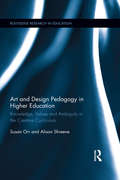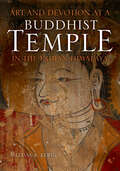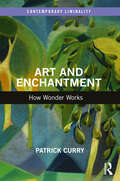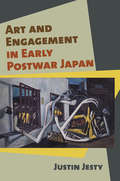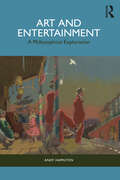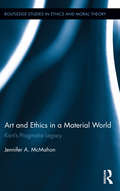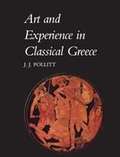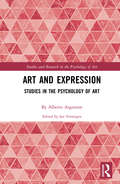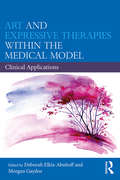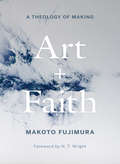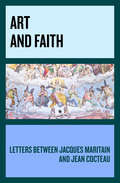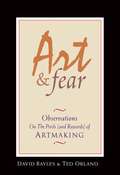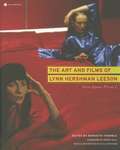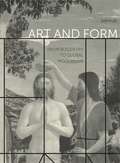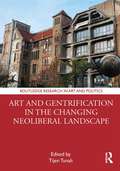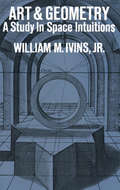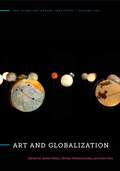- Table View
- List View
Art and Culture in the Multiverse of Metaverses: Immersion, Presence, and Interactivity in the Digital Age (Springer Series on Cultural Computing)
by James HutsonDrawing on the art historical framing of Location, Place, and Identity, this book will examine how the factors of Immersion, Presence, and Interactivity of XR are shaping our understanding of the world and our place within it. Location refers to the specific geographical or spatial context in which a work of art is created or experienced. Place refers to the social, cultural, and historical context of that location. Identity refers to the ways in which individuals and communities construct and express their sense of self and belonging within those contexts. Through case studies and theoretical analysis, Art and Culture in the Multiverse of Metaverses - Immersion, Presence, and Interactivity in the Digital Age, will explore how the factors of Immersion, Presence, and Interactivity of XR can be aligned with these art historical concepts, providing new opportunities for understanding and engaging with Location, Place, and Identity. For example, XR can be used to create immersive experiences of historical locations and cultural sites, allowing users to explore and engage with them in ways that would otherwise be impossible. Additionally, XR can be used to create interactive artworks that engage with issues of identity and belonging, creating new possibilities for self-expression and exploration.
Art And Culture Of The Prehistoric World
by Beatrice D. Brooke Roberto Carvalho de MagalhãesWe know a surprising amount about how people lived before the written word. This strikingly visual book combines photographs of artifacts created by ancient humans with brilliant illustrations, and is guaranteed to appeal to students of all ages. Readers learn about the lives of early humans, from the invention of tools to their religious beliefs. They'll see that we've been a highly inventive species all along.
The Art and Culture of Scandinavian Central Europe, 1550–1720
by Kristoffer NevillePolitically and militarily powerful, early modern Scandinavia played an essential role in the development of Central European culture from the sixteenth to the eighteenth century. In this volume, Kristoffer Neville shows how the cultural ambitions of Denmark and Sweden were inextricably bound to those of other Central European kingdoms.Tracing the visual culture of the Danish and Swedish courts from the Reformation to their eventual decline in the eighteenth century, Neville explains how and why they developed into important artistic centers. He examines major projects by figures largely unknown outside of Northern Europe alongside other, more canonical artists—including Cornelis Floris, Adriaen de Vries, and Johann Bernhard Fischer von Erlach—to propose a more coherent view of this part of Europe, one that rightly includes Scandinavia as a vital component.The seventeenth century has long seemed a bleak moment in Central European culture. Neville’s authoritative and unprecedented study does much to change this perception, showing that the arts did not die in the Reformation and Thirty Years’ War but rather flourished in the Baltic region.
The Art and Culture of Scandinavian Central Europe, 1550–1720
by Kristoffer NevillePolitically and militarily powerful, early modern Scandinavia played an essential role in the development of Central European culture from the sixteenth to the eighteenth century. In this volume, Kristoffer Neville shows how the cultural ambitions of Denmark and Sweden were inextricably bound to those of other Central European kingdoms.Tracing the visual culture of the Danish and Swedish courts from the Reformation to their eventual decline in the eighteenth century, Neville explains how and why they developed into important artistic centers. He examines major projects by figures largely unknown outside of Northern Europe alongside other, more canonical artists—including Cornelis Floris, Adriaen de Vries, and Johann Bernhard Fischer von Erlach—to propose a more coherent view of this part of Europe, one that rightly includes Scandinavia as a vital component.The seventeenth century has long seemed a bleak moment in Central European culture. Neville’s authoritative and unprecedented study does much to change this perception, showing that the arts did not die in the Reformation and Thirty Years’ War but rather flourished in the Baltic region.
Art and Dance in Dialogue: Body, Space, Object
by Sarah Whatley Imogen Racz Katerina Paramana Marie-Louise CrawleyThis interdisciplinary book brings together essays that consider how the body enacts social and cultural rituals in relation to objects, spaces, and the everyday, and how these are questioned, explored, and problematised through, and translated into dance, art, and performance. The chapters are written by significant artists and scholars and consider practices from various locations, including Central and Western Europe, Mexico, and the United States. The authors build on dialogues between, for example, philosophy and museum studies, and memory studies and post-humanism, and engage with a wide range of theory from phenomenology to relational aesthetics to New Materialism. Thus this book represents a unique collection that together considers the continuum between everyday and cultural life, and how rituals and memories are inscribed onto our being. It will be of interest to scholars and practitioners, students and teachers, and particularly those who are curious about the intersections between arts disciplines.
Art and Design in Photoshop: How To Simulate Just About Anything From Great Works Of Art To Urban Graffiti
by Steve CaplinFancy designing your own classic and contemporary movie posters, books and magazine covers?Feel like turning your photographs into works by Turner, Matisse and Magritte?Want to create illustrations in the styles of The Simpsons, steampunk and Victorian engravings?Then you need Art and Design in Photoshop. In this unique book, acclaimed master of photomontage and visual trickery Steve Caplin shows you how to stretch your creative boundaries. Taking the same tried-and-tested practical approach as his best selling How to Cheat in Photoshop titles, Steve's step-by-step instructions recreate a dazzling and diverse array of fabulous design effects. You'll learn how to design everything from wine labels to sushi cartons, from certificates to iPod advertising, from textbooks to pulp fiction.Written by a working pro, the clear guidelines pinpoint exactly what you need to know: how to get slick-looking results with minimum fuss, with a 16-page Photoshop Reference chapter that provides an at-a-glance guide to Photoshop tools and techniques for less experienced users. Steve explains both typography and the design process in a clear, informative and entertaining way.All the images, textures and fonts used in the book are supplied on the downloadable resources. Imaginative, inspirational and fun to use, this book is a must-have for every creative Photoshop user, both amateur and professional.
Art and Design - Let’s Make Art class 9 - MIE
by Mauritius Institute of EducationDiscover the vibrant world of visual arts with 'Creating in 2D: Exploring Media, Composition, Perspective, Color, Painting Techniques, and Figure Drawing.' This comprehensive textbook delves into diverse artistic realms, from mastering color schemes and three-point perspective to honing figure drawing skills. Students will embark on a journey through RecycloEnviro Arts, learning sustainable techniques like tie and dye and batik, while also delving into graphic design fundamentals, encompassing decorative writing, logo design, and landscape patterns through simple ICT software. With a special focus on street art in Mauritius, the textbook highlights local initiatives and murals, fostering an appreciation for art's role in cultural expression and community engagement. Whether aspiring artists or seasoned creatives, learners will find inspiration and practical guidance to unleash their creativity in the dynamic world of 2D art.
Art and Design Pedagogy in Higher Education: Knowledge, Values and Ambiguity in the Creative Curriculum (Routledge Research in Higher Education)
by Susan Orr Alison ShreeveArt and Design Pedagogy in Higher Education provides a contemporary volume that offers a scholarly perspective on tertiary level art and design education. Providing a theoretical lens to examine studio education, the authors suggest a student-centred model of curriculum that supports the development of creativity. The text offers readers analytical frameworks with which to challenge assumptions about the art and design curriculum in higher education. In this volume, Orr and Shreeve critically interrogate the landscape of art and design higher education, offering illuminating viewpoints on pedagogy and assessment. New scholarship is introduced in three key areas: curriculum: the nature and purpose of the creative curriculum and the concept of a ‘sticky curriculum’ that is actively shaped by lecturers, technicians and students; ambiguity, which the authors claim is at the heart of a creative education; value, asking what and whose ideas, practices and approaches are given value and create value within the curriculum. These insights from the perspective of a creative university subject area also offer new ways of viewing other disciplines, and provide a response to a growing educational interest in cross-curricular creativity. This book offers a coherent theory of art and design teaching and learning that will be of great interest to those working in and studying higher education practice and policy, as well as academics and researchers interested in creative education.
Art and Devotion at a Buddhist Temple in the Indian Himalaya (Contemporary Indian Studies)
by Melissa R. KerinA study of a set of sixteenth-century wall paintings at the Gyapagpa Temple in Nako, a village in India’s Himachal Pradesh state.Sixteenth-century wall paintings in a Buddhist temple in the Tibetan cultural zone of northwest India are the focus of this innovative and richly illustrated study. Initially shaped by one set of religious beliefs, the paintings have since been reinterpreted and retraced by a later Buddhist community, subsumed within its religious framework and communal memory. Melissa Kerin traces the devotional, political, and artistic histories that have influenced the paintings’ production and reception over the centuries of their use. Her interdisciplinary approach combines art historical methods with inscriptional translation, ethnographic documentation, and theoretical inquiry to understand religious images in context.“A meticulous and discerning piece of scholarship, one that is skillful in employing multiple methods—visual, linguistic and ethnographic—to create a fuller picture of a region we knew little about. . . . [A] pleasure to read.” —Pika Ghosh, author of Making Kantha, Making Home: Women at Work in Colonial Bengal“Emphasizing the visual as primary evidence in the study of history, especially religious history, Kerin moves Buddhist art from the arena of museum displays, art markets, and aesthetics to the arena of dynamic interdisciplinary discourse, thus reaffirming the significance of in situ study. . . . Recommended.” —Choice“A forceful study on the specificity of Gyapagpa’s painting.” —South Asia Research/DESC>Indian art;south asian art;religious art;buddhist art;Indian history;south asian history;tibetan buddhism;buddhism;religion;indian buddhists;temple art;nako;gyapagpa;social history;political history;painting style;painting traditionART019020 ART / Asian / Indian & South AsianART035000 ART / Subjects & Themes / ReligiousHIS062000 HISTORY / Asia / South / India *REL007050 RELIGION / Buddhism / Tibetan9780253010032Patterns of War—World War IILarry H. Addington
Art and Enchantment: How Wonder Works (Contemporary Liminality)
by Patrick CurryThis book concerns the experience of enchantment in art. Considering the essential characteristics, dynamics and conditions of the experience of enchantment in relation to art, including liminality, it offers studies of different kinds of artistic experience and activity, including painting, music, fiction and poetry, before exploring the possibility of a life oriented to enchantment as the activity of art itself. With attention to the complex relationship between wonder in art and the programmatic disenchantment to which it is often subject, the author draws on the thought of a diverse range of philosophers, sociological theorists and artists, to offer an understanding of art through the idea of enchantment, and enchantment through art. An accessible study, richly illustrated with experience – both that of the author and others – Art and Enchantment will appeal to scholars and students of sociology, anthropology, philosophy, and anyone with interests in the nature of aesthetic experience.
Art and Engagement in Early Postwar Japan
by Justin JestyJustin Jesty’s Art and Engagement in Early Postwar Japan reframes the history of art and its politics in Japan post-1945. This fascinating cultural history addresses our broad understanding of the immediate postwar era moving toward the Cold War and subsequent consolidations of political and cultural life. At the same time, Jesty delves into an examination of the relationship between art and politics that approaches art as a mode of intervention, but he moves beyond the idea that the artwork or artist unilaterally authors political significance to trace how creations and expressive acts may (or may not) actually engage the terms of shared meaning and value.Art and Engagement in Early Postwar Japan centers on a group of social realists on the radical left who hoped to wed their art with anti-capitalist and anti-war activism, a liberal art education movement whose focus on the child inspired innovation in documentary film, and a regional avant-garde group split between ambition and local loyalty. In each case, Jesty examines writings and artworks, together with the social movements they were a part of, to demonstrate how art—or more broadly, creative expression—became a medium for collectivity and social engagement. He reveals a shared if varied aspiration to create a culture founded in amateur-professional interaction, expanded access to the tools of public authorship, and dispersed and participatory cultural forms that intersected easily with progressive movements. Highlighting the transformational nature of the early postwar, Jesty deftly contrasts it with the relative stasis, consolidation, and homogenization of the 1960s.
Art and Entertainment: A Philosophical Exploration
by Andy HamiltonPhilosophers have discussed art – or artistic practices such as poetry – since ancient times. But systems of art and entertainment appeared only in the modern era – in the West, during the 18th and 19th centuries. And philosophers have largely neglected the concept of entertainment. In this book Andy Hamilton explores art and entertainment from a philosophical standpoint. He argues, against modernist theory, that art and entertainment are not opposites, but form a loosely connected conceptual system. Against postmodernism, however, he insists on their vital differences.Hamilton begins by questioning the received modernist view, examining artist-entertainers including Jane Austen, Charles Dickens, Louis Armstrong and Billie Holiday. Entertainment, he argues, is by nature audience-centred – but so is art, in a different way. Thus while art should pass the test of time, entertainment must pass the test of its own time – it has to entertain at the time it is produced. Art and entertainment are inter-dependent concepts, and must be understood together with other aesthetic concepts including criticism, genius, canons and design. These concepts form the subject of later chapters of this book, where Hamilton develops a meritocratic position that is neither elitist nor populist. He also addresses the contemporary charge of cultural appropriation, and qualifies it.An innovative feature of the book is the inclusion of dialogues with artists, critics and academics that help to recast or reformulate the debate. Art and Entertainment: A Philosophical Exploration is essential reading for those working in art and aesthetics, and will also be of interest to those in related disciplines such as cultural studies, music and film studies, with an interest in entertainment.
Art and Ethics in a Material World: Kant’s Pragmatist Legacy (Routledge Studies in Ethics and Moral Theory)
by Jennifer A McMahonIn this book, McMahon argues that a reading of Kant’s body of work in the light of a pragmatist theory of meaning and language (which arguably is a Kantian legacy) leads one to put community reception ahead of individual reception in the order of aesthetic relations. A core premise of the book is that neo-pragmatism draws attention to an otherwise overlooked aspect of Kant’s "Critique of Aesthetic Judgment," and this is the conception of community which it sets forth. While offering an interpretation of Kant’s aesthetic theory, the book focuses on the implications of Kant’s third critique for contemporary art. McMahon draws upon Kant and his legacy in pragmatist theories of meaning and language to argue that aesthetic judgment is a version of moral judgment: a way to cultivate attitudes conducive to community, which plays a pivotal role in the evolution of language, meaning, and knowledge.
Art and Experience in Classical Greece
by J. J. PollittProfessor Pollitt reminds us that the visual arts in Greece, as elsewhere, were primarily vehicles of expression. He does not ignore formal development but always relates this to social and cultural history, which it reflected and from which it grew. While his subject is art, he refers frequently to the literature and philosophy of the period which were shaped by the same influences.
Art and Expression: Studies in the Psychology of Art (Studies and Research in the Psychology of Art)
by Alberto ArgentonPerception of expression distinguishes our cognitive activity in a pervasive, significant and peculiar way, and manifests itself paradigmatically in the vast world of artistic production. Art and Expression examines the cognitive processes involved in artistic production, aesthetic reception, understanding and enjoyment. Using a phenomenological theoretical and methodological framework, developed by Rudolf Arnheim and other important scholars interested in expressive media, Alberto Argenton considers a wide range of artistic works, which span the whole arc of the history of western graphic and pictorial art. Argenton analyses the representational strategies of a dynamic and expressive character that can be reduced to basic aspects of perception, like obliqueness, amodal completion, and the bilateral function of contour, giving new directions relative to the functioning of cognitive activity. Art and Expression is a monument to the fruitful collaboration of art history and psychology, and Argenton has taken great care to construct a meaningful psychological approach to the arts based also on a knowledge of pictorial genres that allows him to systematically situate the works under scrutiny. Art and Expression is an essential resource for postgraduate researchers and scholars interested in visual perception, art, and gestalt psychology.
Art and Expressive Therapies within the Medical Model: Clinical Applications
by Deborah Elkis-Abuhoff Morgan GaydosArt and Expressive Therapies Within the Medical Model explores how to best collaborate across disciplines as art and expressive therapists continue to become increasingly prevalent within the medical community. This collection of diverse chapters from seasoned practitioners in the field introduces readers to art therapy interventions across a variety of artistic approaches, patient demographics, and medical contexts, while paying special attention to new approaches and innovative techniques. This is a cutting-edge resource that illustrates the current work of practitioners on a national and global level while providing a better understating of the integration of biopsychosocial approaches within art and expressive therapies practice.
Art and Faith: A Theology of Making
by Makoto FujimuraFrom a world-renowned painter, an exploration of creativity&’s quintessential—and often overlooked—role in the spiritual life "Makoto Fujimura is the rare artist whose life has something of the same purifying and galvanizing force of his work. His new book brings those two elements—life and art—even closer together, and is a real tonic for our atomized time." —Christian Wiman Conceived over thirty years of painting and creating in his studio, this book is Makoto Fujimura&’s broad and deep exploration of creativity and the spiritual aspects of &“making.&” What he does in the studio is theological work as much as it is aesthetic work. In between pouring precious, pulverized minerals onto handmade paper to create the prismatic, refractive surfaces of his art, he comes into the quiet space in the studio, in a discipline of awareness, waiting, prayer, and praise. Ranging from the Bible to T. S. Eliot, and from Mark Rothko to Japanese Kintsugi technique, he shows how unless we are making something, we cannot know the depth of God&’s being and God&’s grace permeating our lives. This poignant and beautiful book offers the perspective of, in Christian Wiman&’s words, &“an accidental theologian,&” one who comes to spiritual questions always through the prism of art.
Art and Faith: Letters between Jacques Maritain and Jean Cocteau
by Jacques Maritain Jean CocteauThe meaning of poetry and the sociological and political significance of art are dealt with in these letters.
Art and Faith: Letters between Jacques Maritain and Jean Cocteau
by Jacques Maritain Jean CocteauThe meaning of poetry and the sociological and political significance of art are dealt with in these letters.
Art and Fear: Observations On the Perils (and Rewards) of Artmaking
by David Bayles Ted Orland"This is a book about making art. Ordinary art. Ordinary art means something like: all art not made by Mozart. After all, art is rarely made by Mozart-like people; essentially--statistically speaking--there aren't any people like that. Geniuses get made once-a-century or so, yet good art gets made all the time, so to equate the making of art with the workings of genius removes this intimately human activity to a strangely unreachable and unknowable place. For all practical purposes making art can be examined in great detail without ever getting entangled in the very remote problems of genius. " ---from the Introduction Art & Fear explores the way art gets made, the reasons it often doesn't get made, and the nature of the difficulties that cause so many artists to give up along the way. The book's co-authors, David Bayles and Ted Orland, are themselves both working artists, grappling daily with the problems of making art in the real world. Their insights and observations, drawn from personal experience, provide an incisive view into the world of art as it is experienced by artmakers themselves. This is not your typical self-help book. This is a book written by artists, for artists --- it's about what it feels like when artists sit down at their easel or keyboard, in their studio or performance space, trying to do the work they need to do. First published in 1994, Art & Fear quickly became an underground classic. Word-of-mouth response alone--now enhanced by internet posting--has placed it among the best-selling books on artmaking and creativity nationally. Art & Fear has attracted a remarkably diverse audience, ranging from beginning to accomplished artists in every medium, and including an exceptional concentration among students and teachers. The original Capra Press edition of Art & Fear sold 80,000 copies. An excerpt: Today, more than it was however many years ago, art is hard because you have to keep after it so consistently. On so many different fronts. For so little external reward. Artists become veteran artists only by making peace not just with themselves, but with a huge range of issues. You have to find your work. . .
The Art and Films of Lynn Hershman Leeson: Secret Agents, Private I
by Kyle Stephan Robin Held Meredith TrombleLynn Hershman Leeson's groundbreaking installation, performance, photography, video, digital, and film works have earned her an international reputation as a prodigious and innovative artist. This first historical and critical analysis of her work by prominent scholars and the artist herself brings nearly forty years of creative output into focus by tracking the development of her constant themes through each medium. The provocative essay in this volume, ranging from formal to theoretical to psychological to poetical analyses, establish her place at the forefront of contemporary art. Hershman Leeson's work explores vision, spectatorship, and the construction of sexed subjectivity, touching on key feminist concerns relating to the lived experience of the physical body and the body as a medium on which social law and values are inscribed. Her projects of self-analysis and self-mythification explode stable notions of identity.
Art and Form: From Roger Fry to Global Modernism (Refiguring Modernism #28)
by Sam RoseThis important new study reevaluates British art writing and the rise of formalism in the visual arts from 1900 to 1939. Taking Roger Fry as his starting point, Sam Rose rethinks how ideas about form influenced modernist culture and the movement’s significance to art history today.In the context of modernism, formalist critics are often thought to be interested in art rather than life, a stance exemplified in their support for abstract works that exclude the world outside. But through careful attention to early twentieth-century connoisseurship, aesthetics, art education, design, and art in colonial Nigeria and India, Rose builds an expanded account of form based on its engagement with the social world. Art and Form thus opens discussions on a range of urgent topics in art writing, from its history and the constructions of high and low culture to the idea of global modernism. Rose demonstrates the true breadth of formalism and shows how it lends a new richness to thought about art and visual culture in the early to mid-twentieth century.Accessibly written and analytically sophisticated, Art and Form opens exciting new paths of inquiry into the meaning and lasting importance of formalism and its ties to modernism. It will be invaluable for scholars and enthusiasts of art history and visual culture.
Art and Gentrification in the Changing Neoliberal Landscape (Routledge Research in Art and Politics)
by Tijen TunalıArt and Gentrification in the Changing Neoliberal Landscape brings together various disciplinary perspectives and diverse theories on art’s dialectical and evolving relationship with urban regeneration processes. It engages in the accumulated discussions on art’s role in gentrification, yet changes the focus to the growing phenomenon of artistic protests and resistance in the gentrified neighborhoods. Since the 1980s, art and artists’ roles in gentrification have been at the forefront of urban geography research in the subjects of housing, regeneration, displacement and new urban planning. In these accounts the artists have been noted to contribute at all stages of gentrification, from triggering it to eventually being displaced by it themselves. The current presence of art in our neoliberal urban spaces illustrates the constant negotiation between power and resistance. And there is a growing need to recognize art’s shifting and conflicting relationship with gentrification. The chapters presented here share a common thesis that the aesthetic reconfiguration of the neoliberal city does not only allow uneven and exclusionary urban redevelopment strategies but also facilitates the growth of anti-gentrification resistance. The book will be of interest to scholars working in art history, urban cultures, cultural geography and urban studies as well as contemporary art practitioners and policymakers.
Art and Geometry: A Study in Space Intuitions
by William M. IvinsOne of Western civilization's jealously guarded myths is that of Greek cultural supremacy. In this controversial study, William Ivins shows that the limitations of the Greek worldview actually hampered the development of the arts and sciences and gives a stimulating history of the new ideas of the Renaissance, especially in painting and geometry, that freed us from ancient misconceptions. Beginning with the Greeks, the author explains for the general reader the differences between ancient and Renaissance painting and sculpture, proving that the curiously static quality of Greek art arose from a misunderstanding of the laws of perspective. He then shows how this misunderstanding was corrected by Alberti, Pelerin, Durer, and other Renaissance artists who provided the first fruitful investigations of perspective. From there to projective geometry was but a step, and the author covers this major advance in our knowledge through the work of Nicholas of Cusa, Kepler, and Desargues. This book is perhaps the only concise history in English of the development of mathematical perspective and projective geometry. But the author's ability to relate styles in art to advances in geometry and his ingenious theory of the modern "visual" worldview and the Greek "tactile" worldview mean that his book will be provocative not only to mathematical historians but also to art historians and to anyone concerned with the history of thought, from philosopher to layman.
Art and Globalization (The Stone Art Theory Institutes #1)
by James Elkins Zhivka Valiavicharska Alice KimThe “biennale culture” now determines much of the art world. Literature on the worldwide dissemination of art assumes nationalism and ethnic identity, but rarely analyzes it. At the same time there is extensive theorizing about globalization in political theory, cultural studies, postcolonial theory, political economy, sociology, and anthropology. Art and Globalization brings political and cultural theorists together with writers and historians concerned specifically with the visual arts in order to test the limits of the conceptualization of the global in art. Among the major writers on contemporary international art represented in this book are Rasheed Araeen, Joaquín Barriendos, Susan Buck-Morss, John Clark, Iftikhar Dadi, T. J. Demos, Néstor García Canclini, Charles Green, Suman Gupta, Harry Harootunian, Michael Ann Holly, Shigemi Inaga, Fredric Jameson, Caroline Jones, Thomas DaCosta Kaufmann, Anthony D. King, Partha Mitter, Keith Moxey, Saskia Sassen, Ming Tiampo, and C. J. W.-L. Wee. Art and Globalization is the first book in the Stone Art Theory Institutes Series. The five volumes, each on a different theoretical issue in contemporary art, build on conversations held in intensive, weeklong closed meetings. Each volume begins with edited and annotated transcripts of those meetings, followed by assessments written by a wide community of artists, scholars, historians, theorists, and critics. The result is a series of well-informed, contentious, open-ended dialogues about the most difficult theoretical and philosophical problems we face in rethinking the arts today.
